2019 Hyundai Tucson check engine
[x] Cancel search: check enginePage 602 of 685
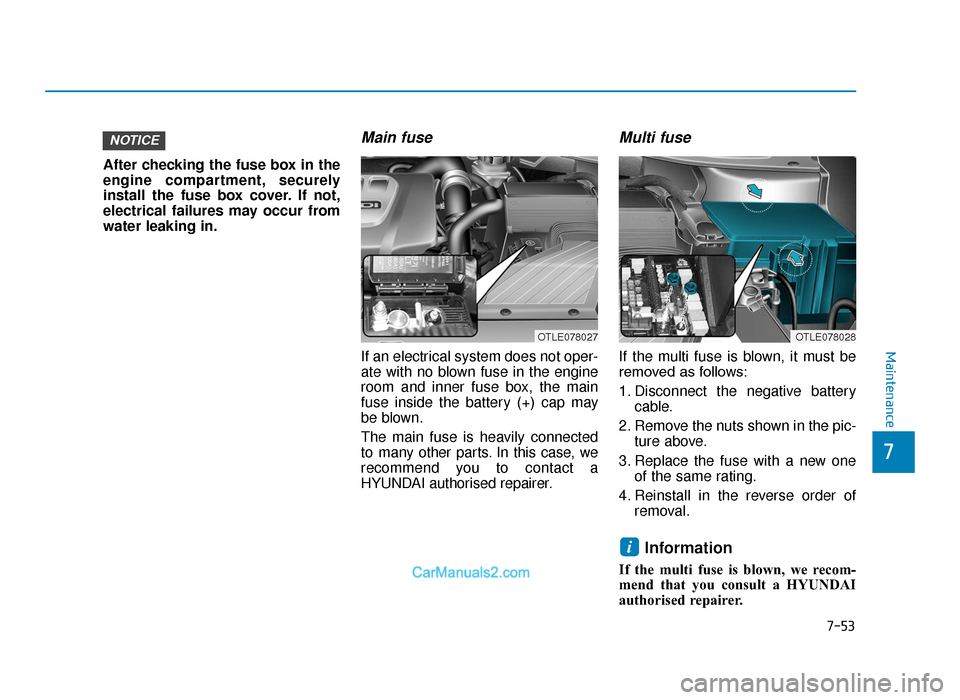
7-53
7
Maintenance
After checking the fuse box in the
engine compartment, securely
install the fuse box cover. If not,
electrical failures may occur from
water leaking in.
Main fuse
If an electrical system does not oper-
ate with no blown fuse in the engine
room and inner fuse box, the main
fuse inside the battery (+) cap may
be blown.
The main fuse is heavily connected
to many other parts. In this case, we
recommend you to contact a
HYUNDAI authorised repairer.
Multi fuse
If the multi fuse is blown, it must be
removed as follows:
1. Disconnect the negative batterycable.
2. Remove the nuts shown in the pic- ture above.
3. Replace the fuse with a new one of the same rating.
4. Reinstall in the reverse order of removal.
Information
If the multi fuse is blown, we recom-
mend that you consult a HYUNDAI
authorised repairer.
i
NOTICE
OTLE078027OTLE078028
TLe UK 7.qxp 5/10/2018 1:35 PM Page 53
Page 628 of 685
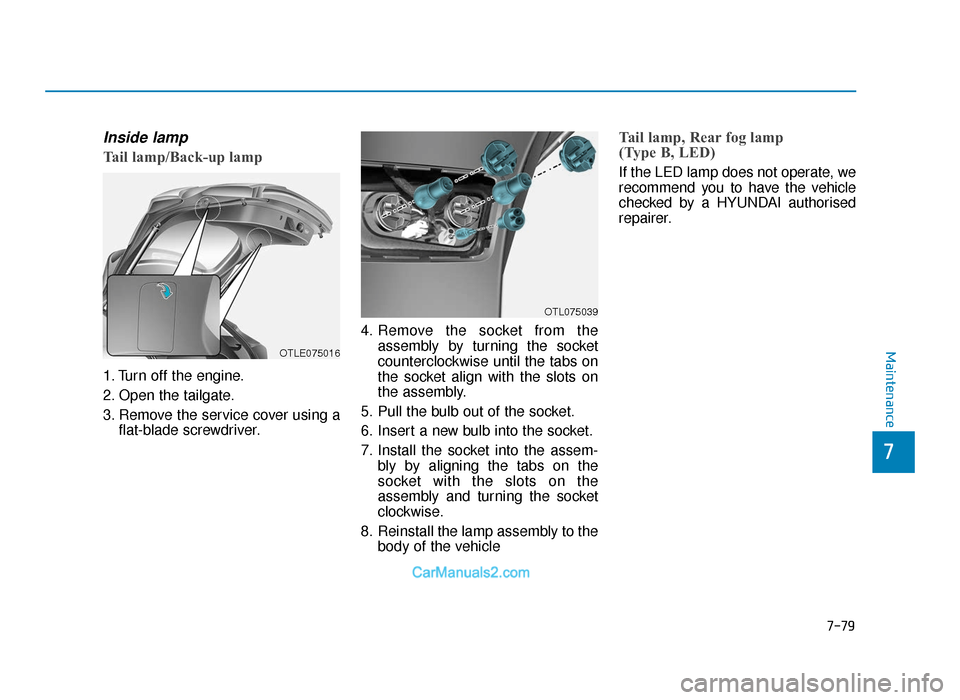
7-79
7
Maintenance
Inside lamp
Tail lamp/Back-up lamp
1. Turn off the engine.
2. Open the tailgate.
3. Remove the service cover using aflat-blade screwdriver. 4. Remove the socket from the
assembly by turning the socket
counterclockwise until the tabs on
the socket align with the slots on
the assembly.
5. Pull the bulb out of the socket.
6. Insert a new bulb into the socket.
7. Install the socket into the assem- bly by aligning the tabs on the
socket with the slots on the
assembly and turning the socket
clockwise.
8. Reinstall the lamp assembly to the body of the vehicle
Tail lamp, Rear fog lamp
(Type B, LED)
If the LED lamp does not operate, we
recommend you to have the vehicle
checked by a HYUNDAI authorised
repairer.
OTLE075016
OTL075039
TLe UK 7.qxp 5/10/2018 1:39 PM Page 79
Page 642 of 685
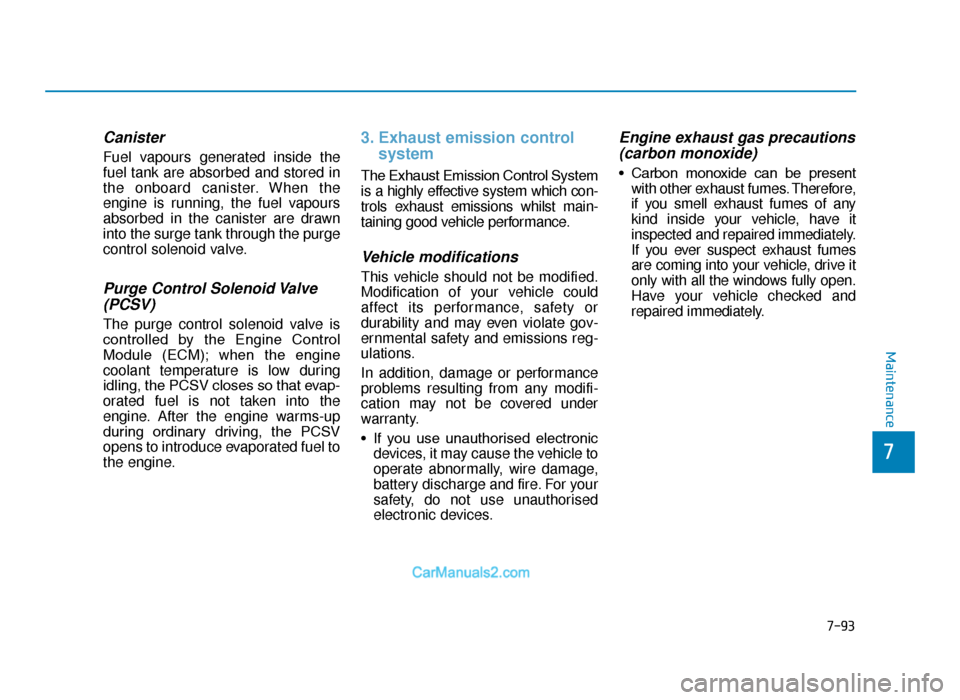
7-93
7
Maintenance
Canister
Fuel vapours generated inside the
fuel tank are absorbed and stored in
the onboard canister. When the
engine is running, the fuel vapours
absorbed in the canister are drawn
into the surge tank through the purge
control solenoid valve.
Purge Control Solenoid Valve(PCSV)
The purge control solenoid valve is
controlled by the Engine Control
Module (ECM); when the engine
coolant temperature is low during
idling, the PCSV closes so that evap-
orated fuel is not taken into the
engine. After the engine warms-up
during ordinary driving, the PCSV
opens to introduce evaporated fuel to
the engine.
3. Exhaust emission control system
The Exhaust Emission Control System
is a highly effective system which con-
trols exhaust emissions whilst main-
taining good vehicle performance.
Vehicle modifications
This vehicle should not be modified.
Modification of your vehicle could
affect its performance, safety or
durability and may even violate gov-
ernmental safety and emissions reg-
ulations.
In addition, damage or performance
problems resulting from any modifi-
cation may not be covered under
warranty.
• If you use unauthorised electronic
devices, it may cause the vehicle to
operate abnormally, wire damage,
battery discharge and fire. For your
safety, do not use unauthorised
electronic devices.
Engine exhaust gas precautions (carbon monoxide)
• Carbon monoxide can be present
with other exhaust fumes. Therefore,
if you smell exhaust fumes of any
kind inside your vehicle, have it
inspected and repaired immediately.
If you ever suspect exhaust fumes
are coming into your vehicle, drive it
only with all the windows fully open.
Have your vehicle checked and
repaired immediately.
TLe UK 7.qxp 5/10/2018 1:40 PM Page 93
Page 645 of 685

7-96
Maintenance
Diesel particulate filter (DPF) (if equipped)
The Diesel Particulate Filter (DPF)
system removes the soot in the
exhaust gas. Unlike a disposable air
filter, the DPF system automatically
burns (oxidizes) and removes the
accumulated soot according to the
driving condition. In order words, the
active burning by engine control sys-
tem and high exhaust gas tempera-
ture caused by normal/high diving
condition burns and removes the
accumulated soot.
However, if the vehicle continues to
be driven at repeated short distance
or driven at low speed for a long
time, the accumulated soot may not
be automatically removed because
of low exhaust gas temperature.
More than a certain amount of soot
deposited, the malfunction indicator
light ( ) illuminates.
When the malfunction indicator light
illuminates, it may turn-off after driv-
ing the vehicle at more than 60km/h
(37 mph) or at more than second
gear with 1500~2500 engine rpm for
a certain time (for about 25 minutes). If the malfunction indicator light
( ) continues to be blinked or the
warning massage “Check exhaust
system” illuminates in spite of the
procedure, visit a professional work-
shop and check the DPF system.
HYUNDAI
recommends to visit a
HYUNDAI authorised repairer/serv-
ice partner.
If you continue to drive with the mal-
function indicator light blinking for a
long time, the DPF system can be
damaged and fuel consumption can
be worsen and the engine durability
can be worsen by oil dilution.Diesel Fuel
(if equipped with DPF)
We recommend you to use only
the regulated diesel fuels, when
your vehicle is equipped with
the DPF system.
When you use other diesel
fuels, which is high in sulfurs
(above 50 ppm) or contains
unspecified additives, it may
damage the DPF system and
cause the white smoke emis-
sion.
CAUTION
TLe UK 7.qxp 6/12/2018 2:51 PM Page 96
Page 646 of 685
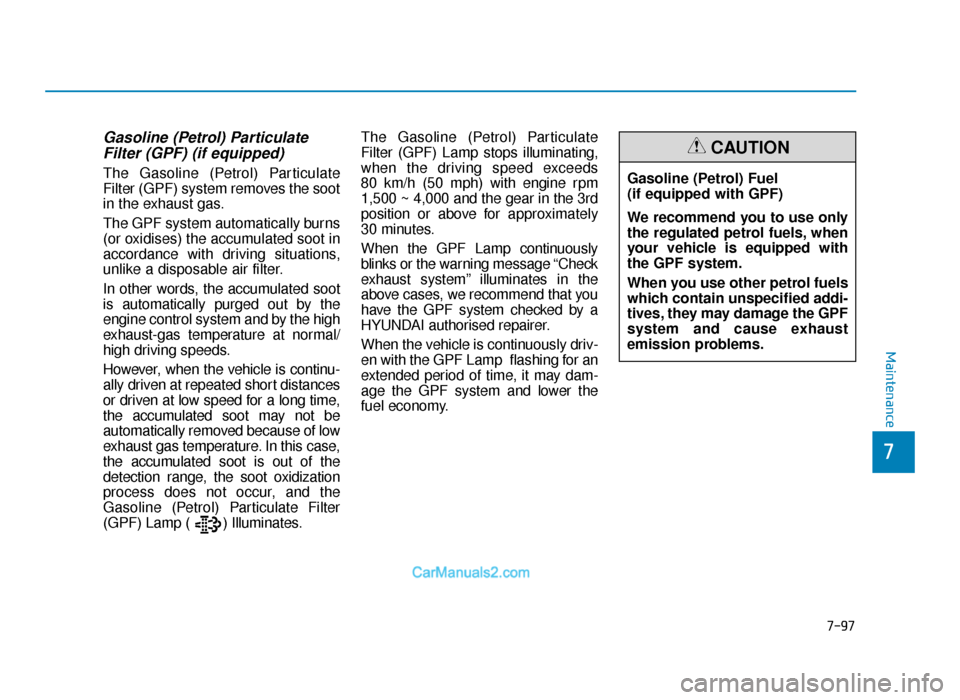
Gasoline (Petrol) ParticulateFilter (GPF) (if equipped)
The Gasoline (Petrol) Particulate
Filter (GPF) system removes the soot
in the exhaust gas.
The GPF system automatically burns
(or oxidises) the accumulated soot in
accordance with driving situations,
unlike a disposable air filter.
In other words, the accumulated soot
is automatically purged out by the
engine control system and by the high
exhaust-gas temperature at normal/
high driving speeds.
However, when the vehicle is continu-
ally driven at repeated short distances
or driven at low speed for a long time,
the accumulated soot may not be
automatically removed because of low
exhaust gas temperature. In this case,
the accumulated soot is out of the
detection range, the soot oxidization
process does not occur, and the
Gasoline (Petrol) Par ticulate Filter
(GPF) Lamp ( ) Illuminates. The Gasoline (P
etrol) Particulate
Filter (GPF) Lamp stops illuminating,
when the driving speed exceeds
80 km/h (50 mph) with engine rpm
1,500 ~ 4,000 and the gear in the 3rd
position or above for approximately
30 minutes.
When the GPF Lamp continuously
blinks or the warning message “Check
exhaust system” illuminates in the
above cases, we recommend that you
have the GPF system checked by a
HYUNDAI authorised repairer.
When the vehicle is continuously driv-
en with the GPF Lamp flashing for an
extended period of time, it may dam-
age the GPF system and lower the
fuel economy.
7-97
7
Maintenance
Gasoline (Petrol) Fuel
(if equipped with GPF)
We recommend you to use only
the regulated petrol fuels, when
your vehicle is equipped with
the GPF system.
When you use other petrol fuels
which contain unspecified addi-
tives, they may damage the GPF
system and cause exhaust
emission problems.
CAUTION
TLe UK 7.qxp 6/12/2018 2:51 PM Page 97
Page 668 of 685
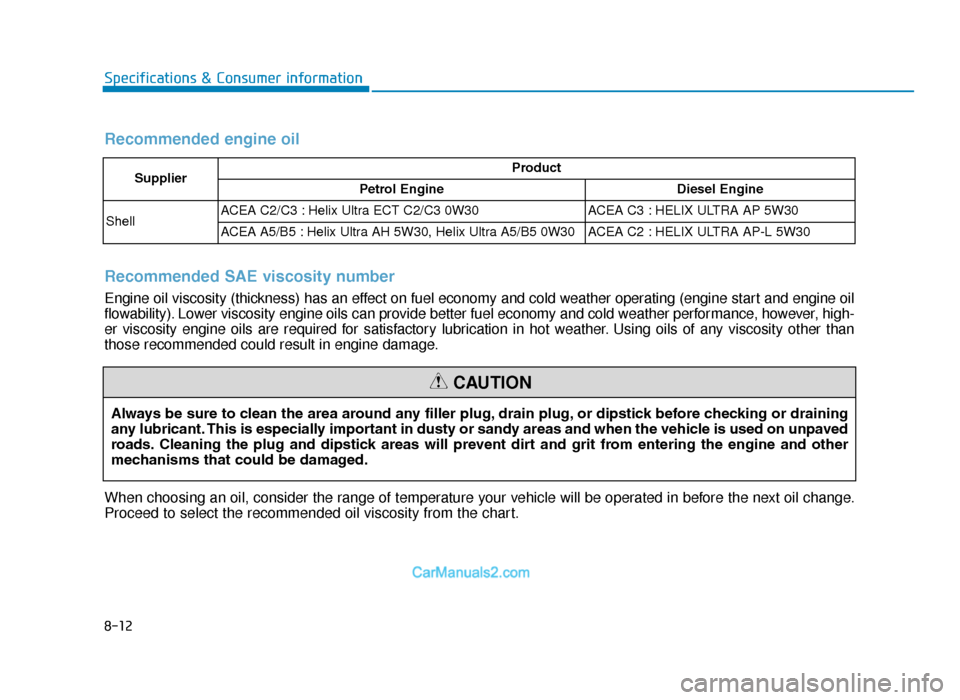
8-12
Specifications & Consumer information
Recommended engine oil
SupplierProduct
Petrol Engine Diesel Engine
Shell ACEA C2/C3 : Helix Ultra ECT C2/C3 0W30
ACEA C3 : HELIX ULTRA AP 5W30
ACEA A5/B5 : Helix Ultra AH 5W30, Helix Ultra A5/B5 0W30 ACEA C2 : HELIX ULTRA AP-L 5W30
Always be sure to clean the area around any filler plug, drain plug, or dipstick before checking or draining
any lubricant. This is especially important in dusty or sandy areas and when the vehicle is used on unpaved
roads. Cleaning the plug and dipstick areas will prevent dirt and grit from entering the engine and other
mechanisms that could be damaged.
CAUTION
Recommended SAE viscosity number
Engine oil viscosity (thickness) has an effect on fuel economy and cold weather operating (engine start and engine oil
flowability). Lower viscosity engine oils can provide better fuel economy and cold weather performance, however, high-
er viscosity engine oils are required for satisfactory lubrication in hot weather. Using oils of any viscosity other than
those recommended could result in engine damage.
When choosing an oil, consider the range of temperature your vehicle will be operated in before the next oil change.
Proceed to select the recommended oil viscosity from the chart.
TLe UK 8.qxp 6/12/2018 3:17 PM Page 12
Page 676 of 685

I-3
Battery.................................................................\
..........7-33Battery capacity label ................................................7-35
Battery recharging......................................................7-35
For best battery service ..............................................7-33
Reset items .................................................................7-36
Before driving .................................................................5-5 Before entering the vehicle ..........................................5-5
Before starting .............................................................5-5
Blind-spot collision warning (BCW) system .............5-100
Bluetooth...............................................................\
........4-32
Bluetooth
®Wireless Technology hands-free..................4-5
Bonnet ........................................................................\
...3-42
Brake/clutch fluid .........................................................7-24
Braking system .............................................................5-43 Anti-lock Brake System (ABS) .................................5-56
Auto hold ...................................................................5-52
Disc brakes wear indicator ........................................5-44
Downhill Brake Control (DBC) ................................5-64
Electronic Parking Brake (EPB) ................................5-46
Electronic Stability Control (ESC) ............................5-58
Emergency Stop Signal (ESS) ...................................5-66
Good braking practices ..............................................5-67
Hill-Start Assist Control (HAC) ................................5-63
Parking brake (hand type) .........................................5-44
Power brakes..............................................................5-43
Vehicle Stability Management (VSM) ......................5-62
Bulb wattage ...................................................................8-3 Cargo security screen .................................................3-180
Centre console storage................................................3-168
Changing tyres ..............................................................6-18
Checking the engine oil level (Diesel Engine).............7-17
Checking the engine oil level (Petrol Engine) .............7-15
Child Restraint System (CRS)......................................2-38
Installing a Child Restraint System (CRS) ................2-41
Our Recommendation: Children always in the rear ..2-38
Selecting a Child Restraint System (CRS) ................2-39
Cigarette lighter ..........................................................3-177
Clearing the vehicle-restarting restriction ..................7-101
Climate control additional features ............................3-167 Automatic ventilation ..............................................3-167
Sunroof inside air recirculation ...............................3-167
To cancel or set the Automatic Ventilation..............3-167
Climate control air filter ...............................................7-29
Clock ........................................................................\
...3-177
Clothes hanger ............................................................3-178
Cool box .....................................................................3-1\
69
Crankcase emission control system..............................7-92
Cruise control .............................................................5-135
Cruise control (with speed limit control) ...................5-130
Cup holder ..................................................................3-171
I
Index
BC
TLe UK Index.qxp 6/12/2018 3:27 PM Page 3
Page 678 of 685

I-5
Emergency Stop Signal (ESS) ......................................5-66
Emergency whilst driving...............................................6-2If the engine stalls at a crossroad or crossing ............6-3
If the engine stalls whilst driving ................................6-2
If you have a flat tyre whilst driving ..........................6-3
Emergency towing .......................................................6-44
Emission control system ...............................................7-92 Adding the urea solution .........................................7-102
Clearing the vehicle-restarting restriction ...............7-101
Crankcase emission control system ...........................7-92
Evaporative emission control system ........................7-92
Exhaust emission control system...............................7-93
Low urea warning message .......................................7-99
Malfunction with the SCR system...........................7-100
Selective catalytic reduction ......................................7-98
Storing the urea solution ..........................................7-105
Urea gauge .................................................................7-98
Urea solution purity .................................................7-105
Engine ........................................................................\
.....8-2
Engine compartment ...............................................1-6, 7-3
Engine coolant ..............................................................7-20
Engine number..............................................................8-15 Engine oil......................................................................7-\
15
Checking the engine oil and filter .............................7-18
Checking the engine oil level (Diesel Engine) ..........7-17
Checking the engine oil level (Petrol Engine) ..........7-15
Engine overheats.............................................................6-8
Engine start/Stop button ...............................................5-11
Engine will not start .......................................................6-4 If the engine doesn't turn over or turns over slowly....6-4
If the engine turns over normally but doesn't start ......6-4
Evaporative emission control system ...........................7-92
Exhaust emission control system .................................7-93
Explanation of scheduled maintenance items ..............7-12
Exterior care .................................................................7-83
Exterior features ...........................................................3-42 Bonnet ........................................................................\
3-42
Fuel filler door ...........................................................3-44
Exterior features .........................................................3-183 Roof rack .................................................................3-183
Exterior overview ....................................................1-2, 1-3
I
Index
TLe UK Index.qxp 6/12/2018 3:27 PM Page 5